Cyclamineus daffodils are small plants with loads of charisma. They’ve got windswept petals, frilly trumpets, and usually a lovely scent that turns heads. Though many cyclamineus daffodils grow only about 1 foot tall, they often show off their undeniable beauty in early spring before other daffodils bloom. So let’s admire 10 types of cyclamineus daffodils with different colors and styles. Hopefully, you’ll see at least one cultivar that’s perfect for your gardening plan.
For those of you new to growing daffodils, you’ll want to know these essential tips before planting:
- Daffodils are easy to grow and bloom sooner when planted as bulbs, not from seed.
- Autumn is the best season for planting daffodil bulbs in Zones 3-9.
- Most daffodils bloom in the spring, but different cultivars will provide flowers during different spring months. So check with your bulb supplier for bloom timing details.
- Daffodils contain a toxic compound called lycorine that people and animals should not ingest. In fact, lycorine could cause severe digestive symptoms like stomach cramps, nausea, and vomiting if eaten. Wearing gloves while handling all parts of daffodil plants, including the bulbs, is also important. This practice prevents skin irritation.
Are you familiar with the specific traits of cyclamineus daffodils? If not, keep reading to learn more about how to identify these pretty little plants with big personalities!
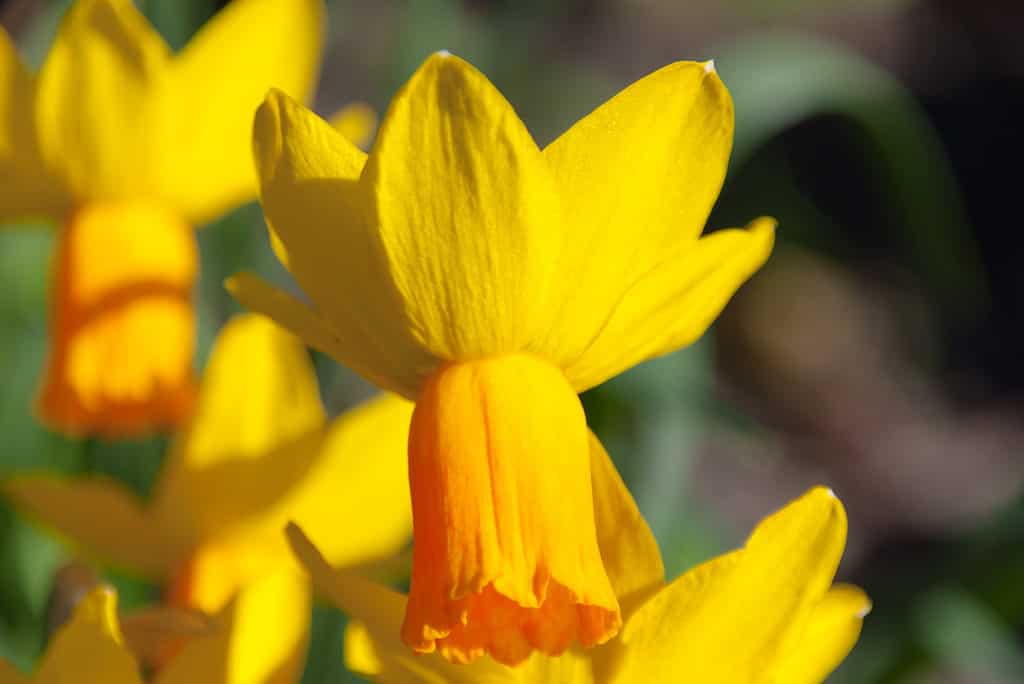
Cyclamineus daffodil flowers usually have significantly inverted (reflexed) petals.
©iStock.com/Hikeandclick
What Are Cyclamineus Daffodils?
Cyclamineus daffodils fall under division #6 of the 13 daffodil divisions. These daffodils have the following traits that help gardeners identify them:
- One daffodil flower per stem
- Strongly reflexed petals
- Short-necked blooms nodding at an angle from the stem
Plus, cyclamineus daffodils are often fragrant plants that grow about (or just above) 1 foot tall.
Now let’s get into our list of 10 types of cyclamineus daffodils beloved by gardeners!

The ‘Cotinga’ cultivar has a pale apricot pink cup.
©Walter Erhardt/Shutterstock.com
1. Narcissus ‘Cotinga’
Botanical Name: Narcissus ‘Cotinga’
Common Names: ‘Cotinga’ Daffodil, ‘Cotinga’ Cyclamineus Daffodil
Hardiness Zones: 3-9
Season in Bloom: Early to Mid-Spring
Daffodil Variety: Division 6 – Cyclamineus
Flower Fragrance: Sweet and noticeable scent
Bloom Colors: Ivory petals with a soft pink or apricot cup
The ‘Cotinga’ daffodil looks like an old-fashioned cultivar with its creamy white petals and soft apricot pink cups. This miniature daffodil also looks like you’re viewing it through a vintage filter compared to the bright colors of some other cyclamineus varieties. However, this type of cyclamineus daffodil is still a showstopper. And ‘Continga’ puts on its show of soft color in your home garden from early to mid-spring.
‘Cotinga’ grows 8-10 inches tall and adds romantic flare with its floaty reflexed petals. In addition, this miniature daffodil provides a pleasing sweet scent floating through your garden beds.

Rich yellow ‘February Gold’ daffodils bloom in early spring.
©Peter Etchells/Shutterstock.com
2. Narcissus ‘February Gold’
Botanical Name: Narcissus ‘February Gold’
Common Names: ‘February Gold’ Daffodil, Miniature Daffodil ‘February Gold’
Hardiness Zones: 3-9
Season in Bloom: Early Spring
Daffodil Variety: Division #6 – Cyclamineus
Flower Fragrance: Very mild to none
Bloom Colors: Rich yellow petals and cups
Standout Awards: Award of Garden Merit – The Royal Horticultural Society
The ‘February Gold’ daffodil shines brightly in spring gardens with its full yellow glow. This miniature type of cyclamineus daffodil blooms very early in spring. The charming plant’s little flowers also tip slightly in a bow as if showing off their deep, frilly cups. In addition, this miniature daffodil has reflexed petals pulled back like tiny wings in the wind.
But don’t let their poetic presence in the garden make you think ‘February Gold’ is a fragile flower. Rest assured; this cyclamineus daffodil is a hardy one. For example, it can survive the colder early spring temps in Zones 3-9!
‘February Gold’ daffodils mature around 1 foot tall, with 3-inch blooms.
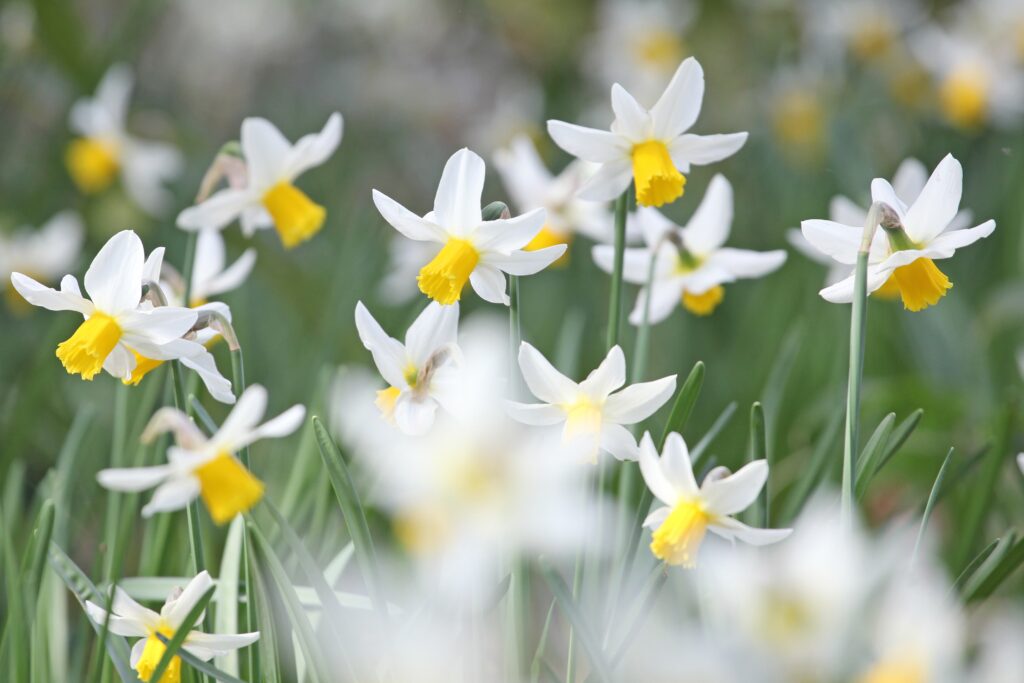
The ‘Jack Snipe’ cyclamineus daffodil is named after a snipe bird.
©Alex Manders/Shutterstock.com
3. Narcissus ‘Jack Snipe’
Botanical Name: Narcissus ‘Jack Snipe’
Common Names: ‘Jack Snipe’ Daffodil, Miniature Daffodil ‘Jack Snipe’
Hardiness Zones: 3-9
Season in Bloom: Early to Mid-Spring
Daffodil Variety: Division #6 – Cyclamineus
Flower Fragrance: Sometimes mildly scented
Bloom Colors: Bright white petals with bright yellow cups
Standout Awards: Award of Garden Merit – The Royal Horticultural Society
Gardeners love the 5-6 weeks’ worth of blooms that ‘Jack Snipe’ miniature daffodils provide. In addition, this cyclamineus daffodil has large flowers (up to 3 inches) for a small plant. Because of these features and more, ‘Jack Snipe’ is a popular cultivar among daffodils that bloom in early to mid-spring.
‘Jack Snipe’ is also a bicolor daffodil with lovely reflexed white petals and ruffled yellow cups. And their tilting flowers with nodding trumpets could be why this cultivar’s namesake is the Jack Snipe bird. For example, this type of wading bird spends its days bobbling its beak in marsh waters, hunting for food like beetles, earthworms, and snails. Fortunately, you won’t have to feed your ‘Jack Snipe’ daffodils any creepy crawlies to keep them healthy and beautiful!
The ‘Jack Snipe’ daffodil is a hardy perennial flower like the ‘February Gold’ cultivar because it can survive early spring temps in Zones 3-9. And you can expect the plant to grow 8-10 inches tall in sunny to partly shady areas of the garden.
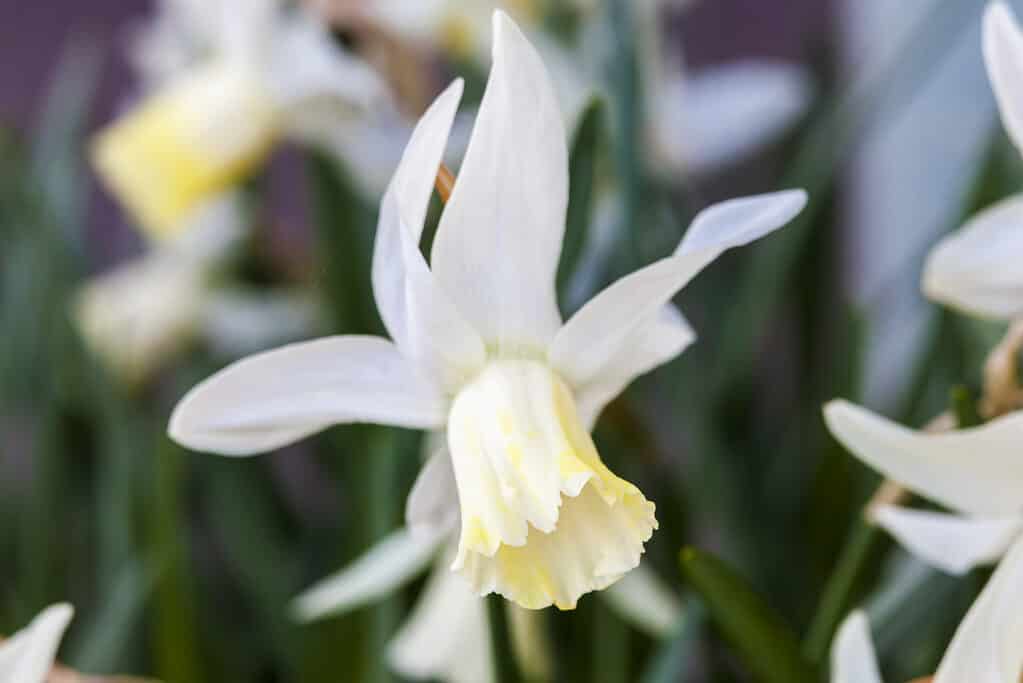
Cyclamineus daffodil ‘Jenny’ has delicate yellow cups that fade to white.
©iStock.com/TonyBaggett
4. Narcissus ‘Jenny’
Botanical Name: Narcissus ‘Jenny’
Common Names: ‘Jenny’ Daffodil, Miniature Daffodil ‘Jenny’
Hardiness Zones: 3-9
Season in Bloom: Early to Mid-Spring
Daffodil Variety: Division #6 – Cyclamineus
Flower Fragrance: Has a strong scent
Bloom Colors: White petals with yellow cups that eventually fade to white
Standout Awards: Award of Garden Merit – The Royal Horticultural Society
The ‘Jenny’ daffodil is another early to mid-spring bloomer. However, unlike some other yellow and white bicolor daffodils, ‘Jenny’ has trumpet-shaped cups that mature from yellow to cream or white.
In addition to their unique coloring, ‘Jenny’ miniature daffodils are notable for their long scalloped cups and wind-hardy reflexed petals. Also, this charming cultivar grows only 8-10 inches tall and features 2.5-inch blooms.
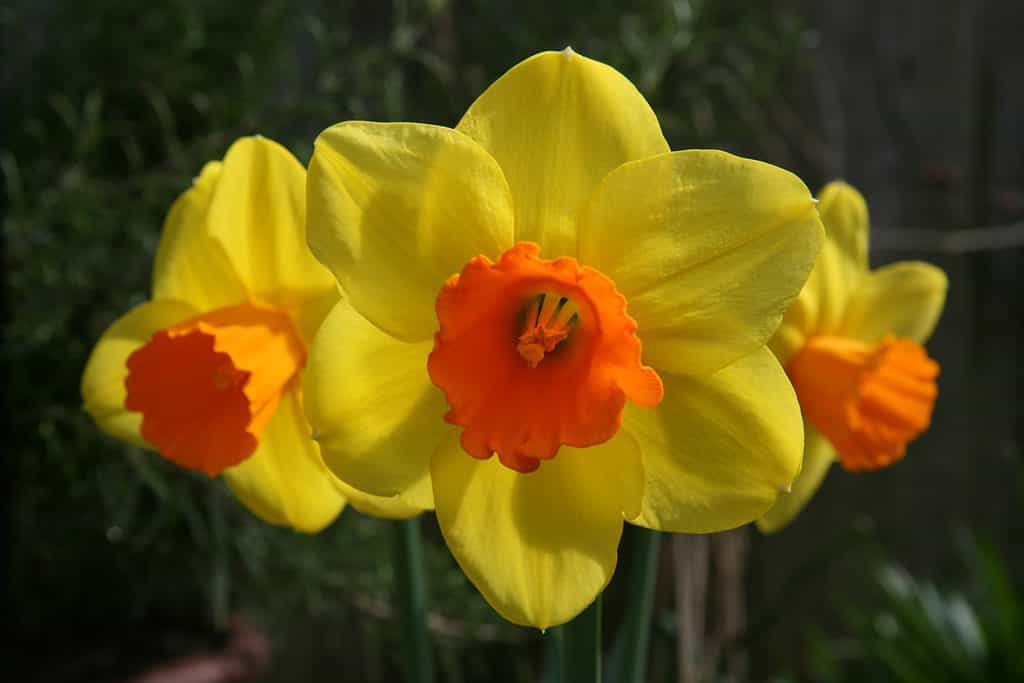
‘Jetfire’ dwarf daffodils are yellow and orange.
©Wirestock Creators/Shutterstock.com
5. Narcissus ‘Jetfire’
Botanical Name: Narcissus ‘Jetfire’
Common Names: ‘Jet Fire’ Daffodil, ‘Jetfire’ Daffodil, Miniature ‘Jetfire’ Daffodil
Hardiness Zones: 3-9
Season in Bloom: Early to Mid-Spring
Daffodil Variety: Division #6 – Cyclamineus
Flower Fragrance: Light floral scent
Bloom Colors: Rich yellow petals with radiant orange cups
Standout Awards: Award of Garden Merit – The Royal Horticultural Society
For a dainty dwarf daffodil, the ‘Jetfire’ cultivar has a powerful name! The vibrant contrast of its yellow petals and orange cups also gives ‘Jetfire’ undeniable garden appeal. Additionally, as with all cyclamineus daffodils, this plant’s flowers are tipped with petals blown back (reflexed).
‘Jetfire’ lightly scented daffodils reach about 10 inches tall at maturity. And they provide striking 3-inch flowers.
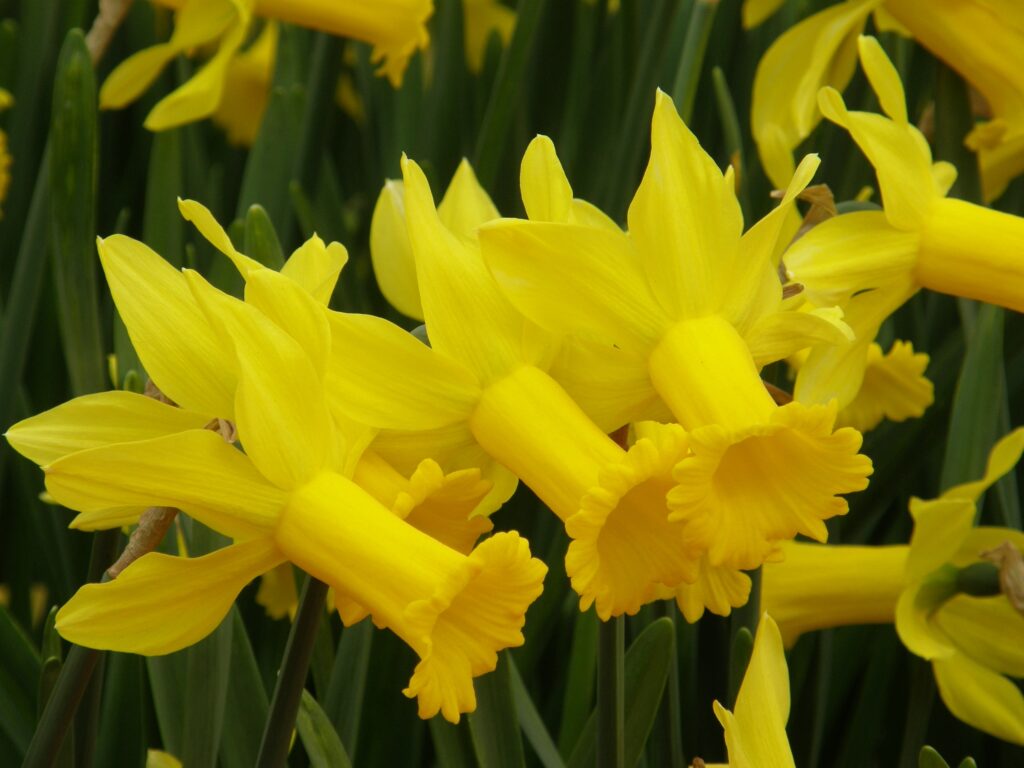
‘Peeping Tom’ is a miniature cyclamineus daffodil with large, showy blooms.
©Sergey V Kalyakin/Shutterstock.com
6. Narcissus ‘Peeping Tom’
Botanical Name: Narcissus ‘Peeping Tom’
Common Names: ‘Peeping Tom’ Daffodil, ‘Peeping Tom’ Miniature Daffodil
Hardiness Zones: 4-8
Season in Bloom: Early to Mid-Spring
Daffodil Variety: Division #6 – Cyclamineus
Flower Fragrance: Blooms are sometimes fragrant
Bloom Colors: Bright yellow petals and cups
Standout Awards: Award of Garden Merit – The Royal Horticultural Society, Wister Award – The American Daffodil Society
If you love big, showy yellow flowers on a miniature daffodil, the ‘Peeping Tom’ cultivar is right for you! With its 4-inch blooms and sunny yellow hues, this type of cyclamineus daffodil is a stunning flower in gardening Zones 4-8. The ‘Peeping Tom’ is also quick to naturalize in sunny areas beyond your garden.
The hardy and long-lasting ‘Peeping Tom’ daffodil grows 8-12 inches tall and has long frilly trumpets. Coupled with its bright and reflexed petals, this nodding miniature daffodil is also an excellent source of sunny cheer in early and mid-spring.
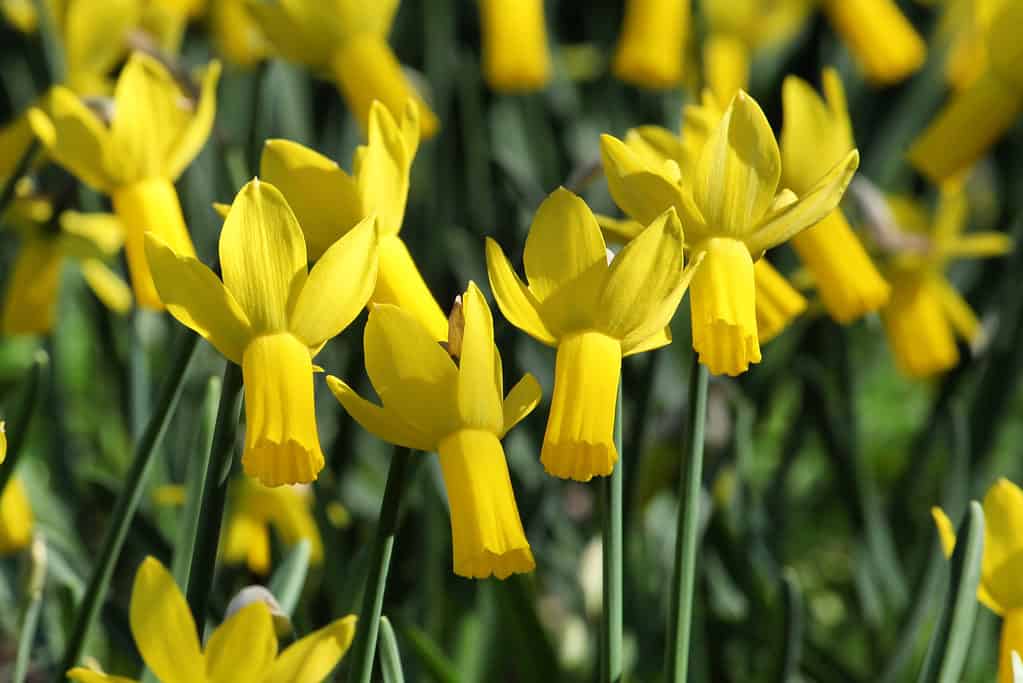
The ‘Rapture’ cultivar is a type of cyclamineus daffodil with long trumpet cups.
©Alex Manders/Shutterstock.com
7. Narcissus ‘Rapture’
Botanical Name: Narcissus ‘Rapture’
Common Names: ‘Rapture’ Daffodil, Cyclamineus ‘Rapture’ Daffodil
Hardiness Zones: 3-7
Season in Bloom: Early Spring
Daffodil Variety: Division #6 – Cyclamineus
Flower Fragrance: Subtle floral scent
Bloom Colors: Sunny yellow petals and cups
Standout Awards: Award of Garden Merit – The Royal Horticultural Society, William G. Pannill Award – The American Daffodil Society
‘Rapture’ is another type of cyclamineus daffodil with a sunny glow. With its nodding yellow blooms aimed at the earth, it reminds us to notice the emerging colors of spring. Additionally, ‘Rapture’ resembles a rocket with inverted petals like dancing flames.
The ‘Rapture’ cultivar should thrive in Zones 3-7, with plants maturing about 14 inches high. And this cyclamineus daffodil will glow with all its rapturous beauty in early spring.
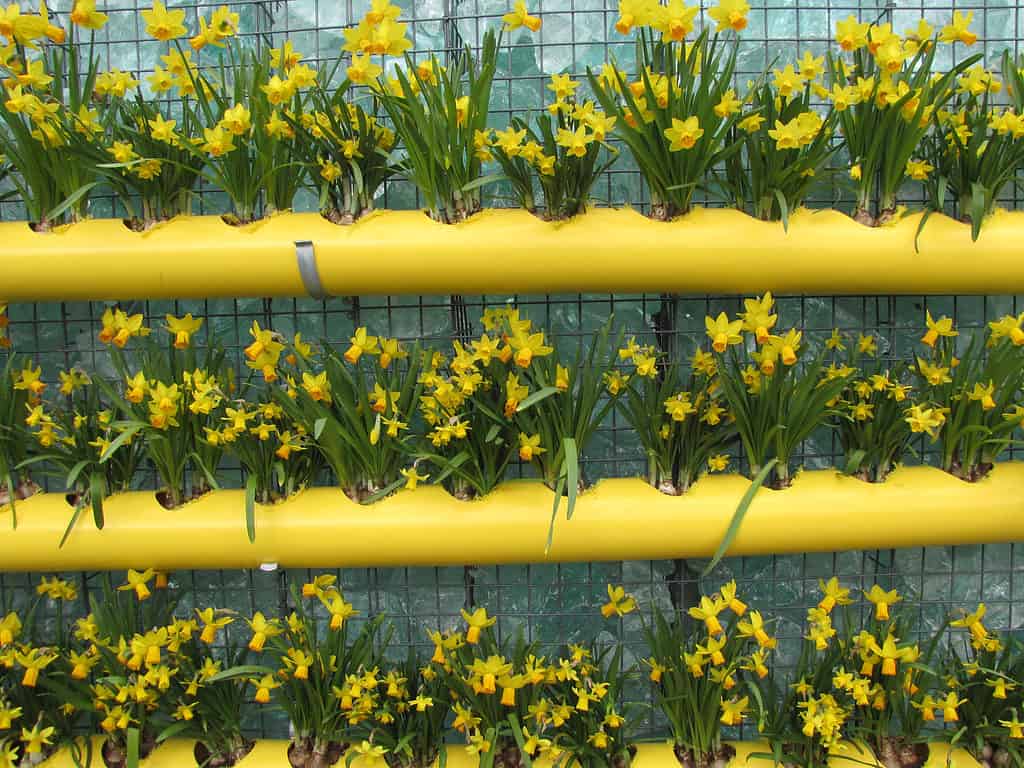
‘Tete-a-Tete’ dwarf daffodils grow 6-8 inches tall.
©iStock.com/Angelique Nijssen
8. Narcissus ‘Tete-a-Tete’
Botanical Name: Narcissus ‘Tete-a-Tete’
Common Names: ‘Tete-a-Tete’ Daffodil, ‘Teta a Tete’ Dwarf Daffodil
Hardiness Zones: 3-9
Season in Bloom: Early to Mid-Spring
Daffodil Variety: Division #6 – Cyclamineus
Flower Fragrance: Delightful and strong scent
Bloom Colors: Shining yellow petals with dusky yellow cups
Standout Awards: The Wister Award – The American Daffodil Society, The Award of Merit – The Royal Horticultural Society
One of the most popular cyclamineus daffodils is the ‘Tete-a-Tete’ cultivar for outdoor gardening and indoor pots:
- The ‘Tete-a-Tete’ is beloved because it’s a pretty miniature daffodil.
- This plant’s bulbs are easy to naturalize and grow as indoor flowers.
- Seeing its dainty yellow and orange flowers brightens even the gloomiest day.
‘Tete-at-Tete’ daffodils stop growing at about 6-8 inches tall, and their blossoms open about 3 inches wide. Also, note that this dwarf daffodil blooms in early to mid-spring.
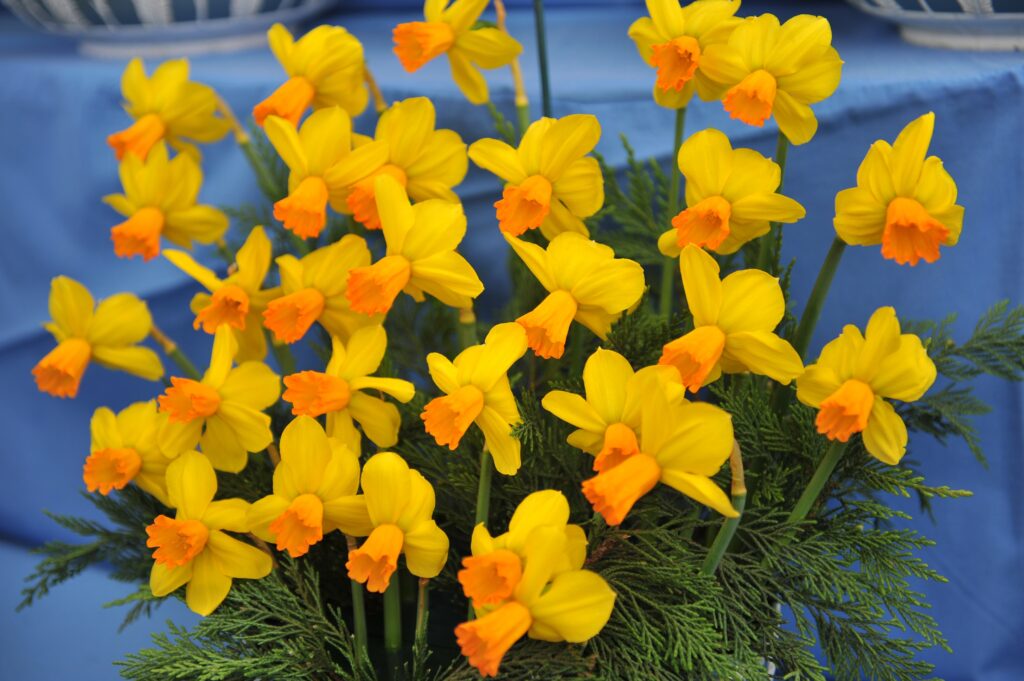
‘Velocity’ miniature daffodils have yellow reflexed petals and bright orange cups.
©Sergey V Kalyakin/Shutterstock.com
9. Narcissus ‘Velocity’
Botanical Name: Narcissus ‘Velocity’
Common Names: ‘Velocity’ Daffodil, ‘Velocity’ Miniature Daffodil
Hardiness Zones: 3-8
Season in Bloom: Early to Mid-Spring
Daffodil Variety: Division #6 – Cyclamineus
Flower Fragrance: A slightly sweet floral scent
Bloom Colors: Neon yellow petals with bright orange cups
The ‘Velocity’ cultivar is a type of cyclamineus daffodil with a nearly-neon look from its brightly-colored petals and cups. You can’t help but stare with awe at its bright yellow reflexed petals that angle gently back from bright orange trumpets.
‘Velocity’ is a miniature daffodil that reaches 8-10 inches tall at maturity. In addition, this eye-catching daffodil produces 3-inch flowers.
Fun Fact: The ‘Velocity’ cultivar is a hybrid plant created from another cyclamineus daffodil on our list, the ‘Jetfire!’
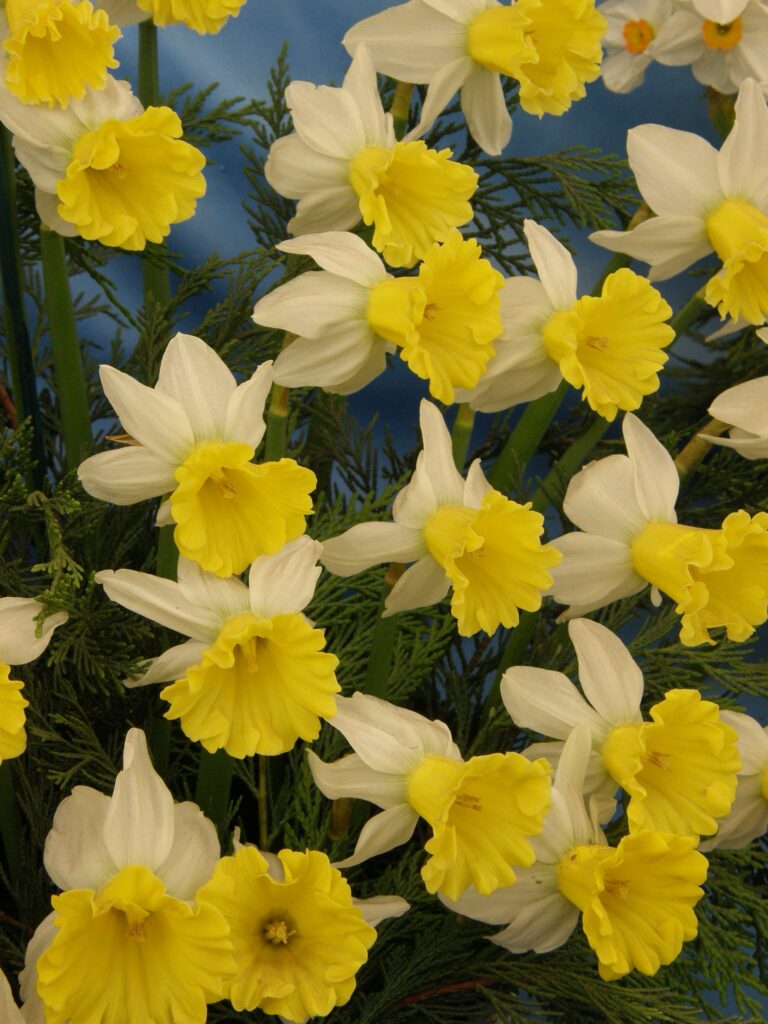
‘Wisley’ cyclamineus daffodils are named after the Wisley Garden, managed by the Royal Horticultural Society.
©Sergey V Kalyakin/Shutterstock.com
10. Narcissus ‘Wisley’
Botanical Name: Narcissus ‘Wisley’
Common Names: ‘Wisley’ Daffodil, ‘Wisley’ Cyclamineus Daffodil
Hardiness Zones: 4-9
Season in Bloom: Early to Mid Spring
Daffodil Variety: Division #6 – Cyclamineus
Bloom Colors: Brightly white petals with a lemon-yellow cup that matures to white
Standout Awards: Award of Garden Merit – The Royal Horticultural Society
The ‘Wisley’ daffodil is named for the massive flagship garden managed by the Royal Horticultural Society in the UK. In addition to its beautiful namesake, this gorgeous type of cyclamineus daffodil is sure to capture attention!
With its snowy-white petals and bright yellow cups, ‘Wisley’ dazzles in early to mid-spring for Zones 4-9. In addition, its yellow flower cups will fade to white as they mature.
‘Wisley’ miniature daffodils grow up to 12 inches tall. Additionally, they produce large flowers with reflexed petals and slightly flared cups with deep ruffles.
Fun fact: The ‘Wisley’ cultivar was fathered by the ‘Peeping Tom’ daffodil, also featured in this post.
Cyclamineus Daffodils Are Small Spring Flowers with Big Personalities!
For small blooming plants with a big presence in spring gardens, cyclamineus daffodils are hard to beat. Especially when grown in big groups, these delightful spring flowers are beloved for their fancy cups and fluttery reflexed petals. And they’re some of the earliest daffodil plants to bloom every spring. Its incredible beauty makes us want to grow every type of cyclamineus daffodil we can find! How about you?
The photo featured at the top of this post is © Helen J Davies/Shutterstock.com
Thank you for reading! Have some feedback for us? Contact the AZ Animals editorial team.






